An official website of the United States government
 United States Department of Labor
United States Department of Labor
Farming, Fishing, and Forestry Occupations comprises the following occupations: First-Line Supervisors of Farming, Fishing, and Forestry Workers; Agricultural Inspectors; Animal Breeders; Graders and Sorters, Agricultural Products; Agricultural Workers, All Other; Agricultural Equipment Operators; Farmworkers, Farm, Ranch, and Aquacultural Animals; Farmworkers and Laborers, Crop, Nursery, and Greenhouse; Forest and Conservation Workers; Logging Workers, All Other; Log Graders and Scalers; Fallers; Logging Equipment Operators
Employment estimate and mean wage estimates for Farming, Fishing, and Forestry Occupations:
| Employment (1) | Employment RSE (3) |
Mean hourly wage |
Mean annual wage (2) |
Wage RSE (3) |
|---|---|---|---|---|
| 452,490 | 0.8 % | $ 16.70 | $ 34,730 | 0.7 % |
Percentile wage estimates for Farming, Fishing, and Forestry Occupations:
| Percentile | 10% | 25% | 50% (Median) |
75% | 90% |
|---|---|---|---|---|---|
| Hourly Wage | $ 12.98 | $ 14.00 | $ 14.36 | $ 17.86 | $ 23.14 |
| Annual Wage (2) | $ 26,990 | $ 29,120 | $ 29,860 | $ 37,140 | $ 48,140 |
Industries with the highest published employment and wages for Farming, Fishing, and Forestry Occupations are provided. For a list of all industries with employment in Farming, Fishing, and Forestry Occupations, see the Create Customized Tables function.
Industries with the highest levels of employment in Farming, Fishing, and Forestry Occupations:
| Industry | Employment (1) | Percent of industry employment | Hourly mean wage | Annual mean wage (2) |
|---|---|---|---|---|
| Support Activities for Crop Production | 248,670 | 74.11 | $ 15.42 | $ 32,070 |
| Logging | 27,300 | 57.97 | $ 23.14 | $ 48,130 |
| Merchant Wholesalers, Nondurable Goods (4241, 4247, and 4249 only) | 21,890 | 4.18 | $ 16.88 | $ 35,100 |
| Lawn and Garden Equipment and Supplies Stores | 16,290 | 8.95 | $ 15.43 | $ 32,100 |
| Support Activities for Animal Production | 14,810 | 46.96 | $ 16.42 | $ 34,150 |
Industries with the highest concentration of employment in Farming, Fishing, and Forestry Occupations:
| Industry | Employment (1) | Percent of industry employment | Hourly mean wage | Annual mean wage (2) |
|---|---|---|---|---|
| Support Activities for Crop Production | 248,670 | 74.11 | $ 15.42 | $ 32,070 |
| Logging | 27,300 | 57.97 | $ 23.14 | $ 48,130 |
| Support Activities for Animal Production | 14,810 | 46.96 | $ 16.42 | $ 34,150 |
| Farm Product Raw Material Merchant Wholesalers | 11,960 | 17.53 | $ 15.62 | $ 32,490 |
| Lawn and Garden Equipment and Supplies Stores | 16,290 | 8.95 | $ 15.43 | $ 32,100 |
Top paying industries for Farming, Fishing, and Forestry Occupations:
| Industry | Employment (1) | Percent of industry employment | Hourly mean wage | Annual mean wage (2) |
|---|---|---|---|---|
| Pulp, Paper, and Paperboard Mills | 50 | 0.06 | $ 27.06 | $ 56,280 |
| Bakeries and Tortilla Manufacturing | (8) | (8) | $ 26.23 | $ 54,560 |
| Electric Power Generation, Transmission and Distribution | (8) | (8) | $ 25.33 | $ 52,690 |
| Promoters of Performing Arts, Sports, and Similar Events | 90 | 0.11 | $ 24.79 | $ 51,570 |
| Other Support Services | 330 | 0.12 | $ 23.86 | $ 49,630 |
States and areas with the highest published employment, location quotients, and wages for Farming, Fishing, and Forestry Occupations are provided. For a list of all areas with employment in Farming, Fishing, and Forestry Occupations, see the Create Customized Tables function.
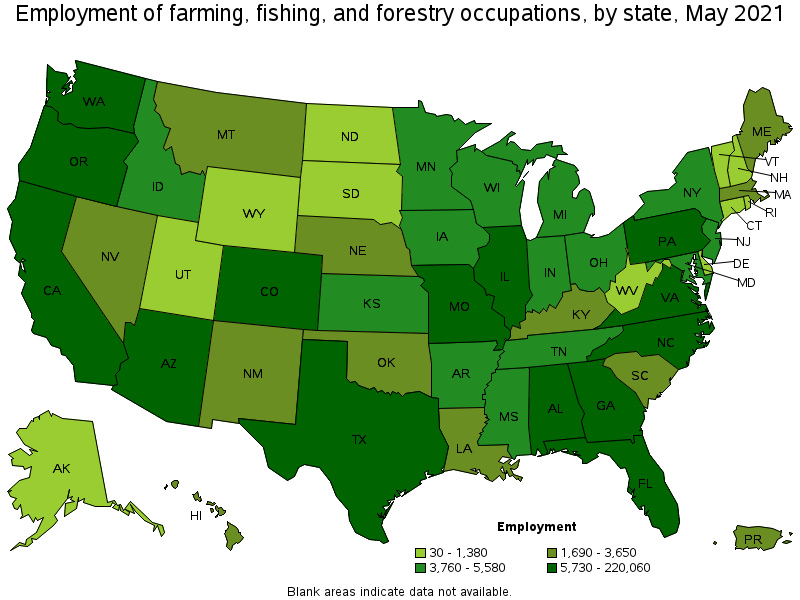
States with the highest employment level in Farming, Fishing, and Forestry Occupations:
| State | Employment (1) | Employment per thousand jobs | Location quotient (9) | Hourly mean wage | Annual mean wage (2) |
|---|---|---|---|---|---|
| California | 220,060 | 13.31 | 4.15 | $ 16.08 | $ 33,450 |
| Washington | 19,080 | 5.95 | 1.85 | $ 18.29 | $ 38,050 |
| Texas | 16,050 | 1.31 | 0.41 | $ 15.64 | $ 32,520 |
| Florida | 16,000 | 1.86 | 0.58 | $ 14.88 | $ 30,940 |
| Oregon | 14,050 | 7.70 | 2.40 | $ 18.29 | $ 38,050 |
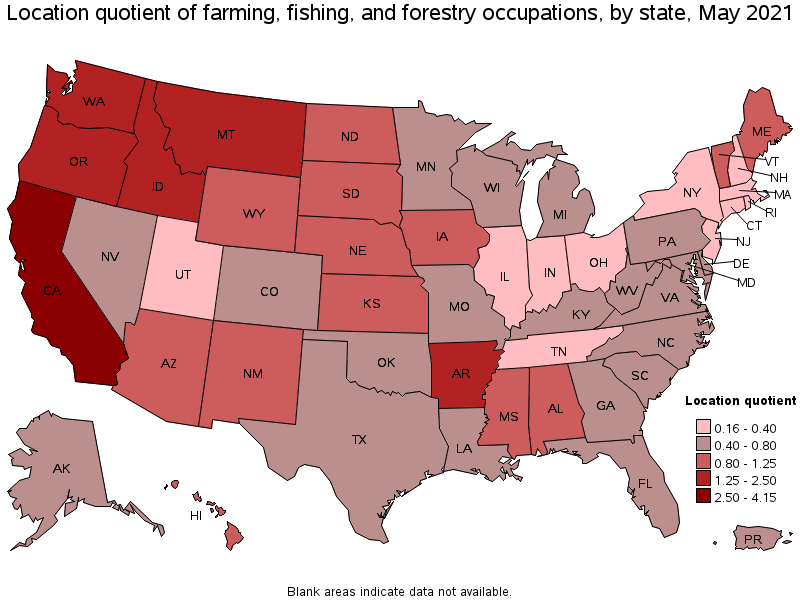
States with the highest concentration of jobs and location quotients in Farming, Fishing, and Forestry Occupations:
| State | Employment (1) | Employment per thousand jobs | Location quotient (9) | Hourly mean wage | Annual mean wage (2) |
|---|---|---|---|---|---|
| California | 220,060 | 13.31 | 4.15 | $ 16.08 | $ 33,450 |
| Oregon | 14,050 | 7.70 | 2.40 | $ 18.29 | $ 38,050 |
| Idaho | 5,450 | 7.19 | 2.24 | $ 17.13 | $ 35,620 |
| Washington | 19,080 | 5.95 | 1.85 | $ 18.29 | $ 38,050 |
| Arkansas | 5,000 | 4.20 | 1.31 | $ 17.26 | $ 35,910 |
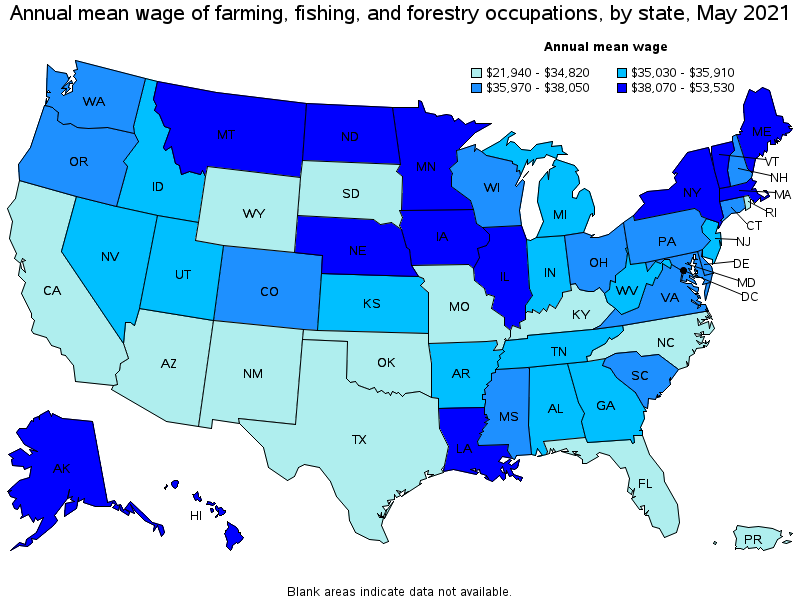
Top paying states for Farming, Fishing, and Forestry Occupations:
| State | Employment (1) | Employment per thousand jobs | Location quotient (9) | Hourly mean wage | Annual mean wage (2) |
|---|---|---|---|---|---|
| District of Columbia | (8) | (8) | (8) | $ 25.73 | $ 53,530 |
| Hawaii | 1,690 | 3.08 | 0.96 | $ 21.55 | $ 44,820 |
| Alaska | 610 | 2.06 | 0.64 | $ 21.15 | $ 43,990 |
| Maine | 1,830 | 3.10 | 0.96 | $ 19.40 | $ 40,360 |
| Montana | 1,890 | 4.02 | 1.25 | $ 19.24 | $ 40,020 |
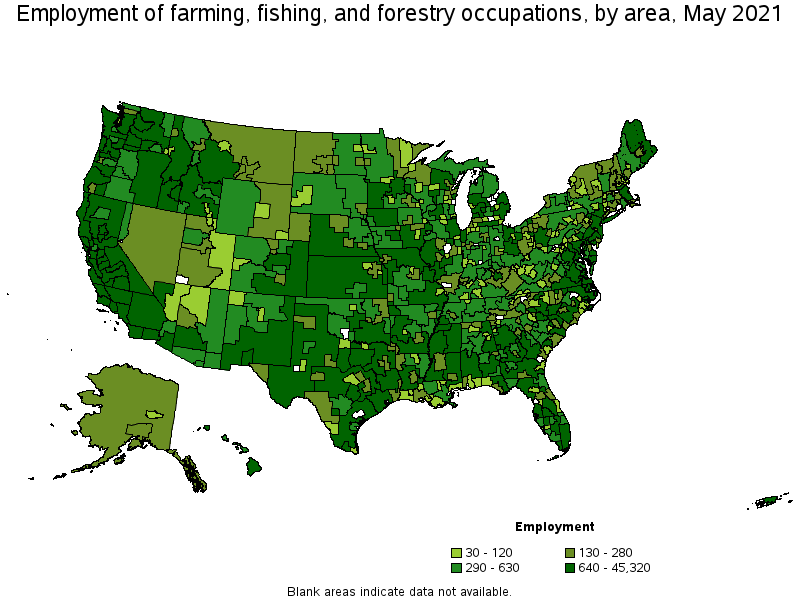
Metropolitan areas with the highest employment level in Farming, Fishing, and Forestry Occupations:
| Metropolitan area | Employment (1) | Employment per thousand jobs | Location quotient (9) | Hourly mean wage | Annual mean wage (2) |
|---|---|---|---|---|---|
| Bakersfield, CA | 45,320 | 145.89 | 45.42 | $ 14.68 | $ 30,540 |
| Salinas, CA | 31,460 | 186.05 | 57.93 | $ 16.50 | $ 34,310 |
| Fresno, CA | 22,940 | 61.14 | 19.04 | $ 15.35 | $ 31,920 |
| Visalia-Porterville, CA | 21,220 | 141.87 | 44.17 | $ 15.12 | $ 31,450 |
| Santa Maria-Santa Barbara, CA | 11,100 | 57.13 | 17.79 | $ 15.96 | $ 33,200 |
| Madera, CA | 7,440 | 155.80 | 48.51 | $ 14.98 | $ 31,160 |
| Riverside-San Bernardino-Ontario, CA | 7,320 | 4.79 | 1.49 | $ 16.42 | $ 34,150 |
| Stockton-Lodi, CA | 7,000 | 27.31 | 8.50 | $ 16.15 | $ 33,600 |
| Modesto, CA | 6,800 | 37.62 | 11.71 | $ 15.42 | $ 32,070 |
| Oxnard-Thousand Oaks-Ventura, CA | 5,910 | 19.93 | 6.21 | $ 16.07 | $ 33,420 |
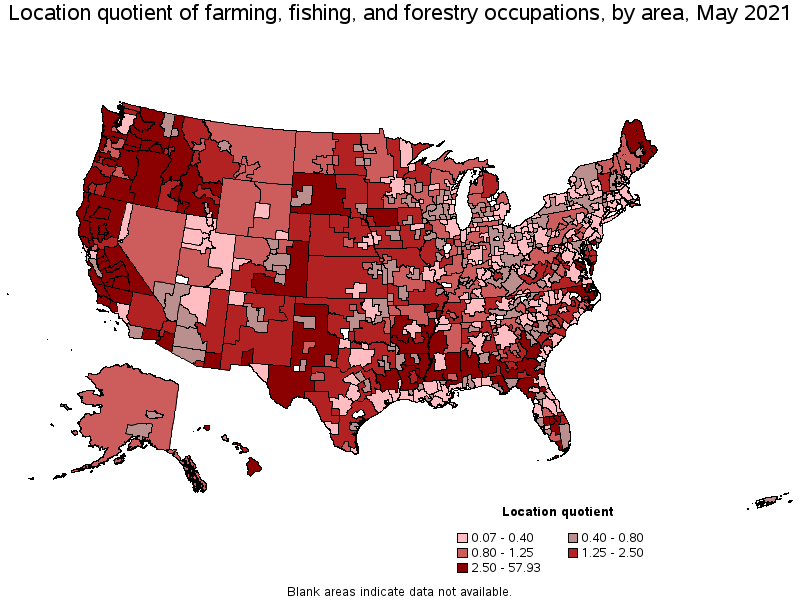
Metropolitan areas with the highest concentration of jobs and location quotients in Farming, Fishing, and Forestry Occupations:
| Metropolitan area | Employment (1) | Employment per thousand jobs | Location quotient (9) | Hourly mean wage | Annual mean wage (2) |
|---|---|---|---|---|---|
| Salinas, CA | 31,460 | 186.05 | 57.93 | $ 16.50 | $ 34,310 |
| Madera, CA | 7,440 | 155.80 | 48.51 | $ 14.98 | $ 31,160 |
| Bakersfield, CA | 45,320 | 145.89 | 45.42 | $ 14.68 | $ 30,540 |
| Visalia-Porterville, CA | 21,220 | 141.87 | 44.17 | $ 15.12 | $ 31,450 |
| El Centro, CA | 5,790 | 98.69 | 30.73 | $ 15.56 | $ 32,370 |
| Merced, CA | 5,790 | 80.55 | 25.08 | $ 15.40 | $ 32,030 |
| Yuma, AZ | 4,930 | 78.94 | 24.58 | $ 14.63 | $ 30,430 |
| Hanford-Corcoran, CA | 3,070 | 71.74 | 22.34 | $ 15.69 | $ 32,640 |
| Fresno, CA | 22,940 | 61.14 | 19.04 | $ 15.35 | $ 31,920 |
| Santa Maria-Santa Barbara, CA | 11,100 | 57.13 | 17.79 | $ 15.96 | $ 33,200 |
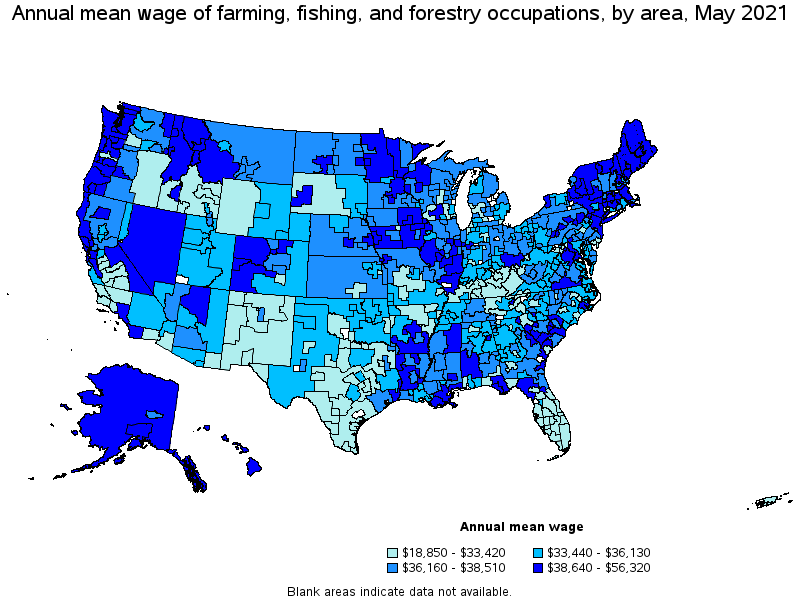
Top paying metropolitan areas for Farming, Fishing, and Forestry Occupations:
| Metropolitan area | Employment (1) | Employment per thousand jobs | Location quotient (9) | Hourly mean wage | Annual mean wage (2) |
|---|---|---|---|---|---|
| Longview, WA | 450 | 11.60 | 3.61 | $ 27.08 | $ 56,320 |
| Houma-Thibodaux, LA | 40 | 0.45 | 0.14 | $ 25.53 | $ 53,090 |
| Lewiston, ID-WA | 120 | 4.47 | 1.39 | $ 25.00 | $ 52,000 |
| Coeur d'Alene, ID | 130 | 2.03 | 0.63 | $ 24.76 | $ 51,500 |
| Olympia-Tumwater, WA | 300 | 2.69 | 0.84 | $ 24.24 | $ 50,430 |
| Urban Honolulu, HI | 580 | 1.47 | 0.46 | $ 23.98 | $ 49,880 |
| Corvallis, OR | 200 | 5.62 | 1.75 | $ 23.79 | $ 49,490 |
| Mount Vernon-Anacortes, WA | 260 | 5.44 | 1.69 | $ 23.61 | $ 49,110 |
| Spokane-Spokane Valley, WA | 470 | 2.01 | 0.63 | $ 22.93 | $ 47,690 |
| San Francisco-Oakland-Hayward, CA | 2,390 | 1.07 | 0.33 | $ 22.49 | $ 46,770 |
Nonmetropolitan areas with the highest employment in Farming, Fishing, and Forestry Occupations:
| Nonmetropolitan area | Employment (1) | Employment per thousand jobs | Location quotient (9) | Hourly mean wage | Annual mean wage (2) |
|---|---|---|---|---|---|
| Eastern Washington nonmetropolitan area | 3,200 | 33.95 | 10.57 | $ 17.47 | $ 36,340 |
| North Valley-Northern Mountains Region of California nonmetropolitan area | 3,160 | 32.24 | 10.04 | $ 18.22 | $ 37,900 |
| North Coast Region of California nonmetropolitan area | 2,290 | 22.91 | 7.13 | $ 19.96 | $ 41,520 |
| South Georgia nonmetropolitan area | 2,250 | 12.26 | 3.82 | $ 17.40 | $ 36,200 |
| Eastern Oregon nonmetropolitan area | 2,230 | 31.99 | 9.96 | $ 15.41 | $ 32,050 |
Nonmetropolitan areas with the highest concentration of jobs and location quotients in Farming, Fishing, and Forestry Occupations:
| Nonmetropolitan area | Employment (1) | Employment per thousand jobs | Location quotient (9) | Hourly mean wage | Annual mean wage (2) |
|---|---|---|---|---|---|
| Eastern Washington nonmetropolitan area | 3,200 | 33.95 | 10.57 | $ 17.47 | $ 36,340 |
| North Valley-Northern Mountains Region of California nonmetropolitan area | 3,160 | 32.24 | 10.04 | $ 18.22 | $ 37,900 |
| Eastern Oregon nonmetropolitan area | 2,230 | 31.99 | 9.96 | $ 15.41 | $ 32,050 |
| North Coast Region of California nonmetropolitan area | 2,290 | 22.91 | 7.13 | $ 19.96 | $ 41,520 |
| South Florida nonmetropolitan area | 1,610 | 21.26 | 6.62 | $ 14.57 | $ 30,310 |
Top paying nonmetropolitan areas for Farming, Fishing, and Forestry Occupations:
| Nonmetropolitan area | Employment (1) | Employment per thousand jobs | Location quotient (9) | Hourly mean wage | Annual mean wage (2) |
|---|---|---|---|---|---|
| Western Washington nonmetropolitan area | 1,170 | 9.79 | 3.05 | $ 25.20 | $ 52,420 |
| Alaska nonmetropolitan area | 260 | 2.69 | 0.84 | $ 23.63 | $ 49,140 |
| Northwestern Idaho nonmetropolitan area | 1,120 | 16.01 | 4.98 | $ 23.41 | $ 48,700 |
| Coast Oregon nonmetropolitan area | 1,470 | 13.37 | 4.16 | $ 23.17 | $ 48,190 |
| West Montana nonmetropolitan area | 510 | 6.68 | 2.08 | $ 21.12 | $ 43,940 |
These estimates are calculated with data collected from employers in all industry sectors, all metropolitan and nonmetropolitan areas, and all states and the District of Columbia.
The percentile wage estimate is the value of a wage below which a certain percent of workers fall. The median wage is the 50th percentile wage estimate—50 percent of workers earn less than the median and 50 percent of workers earn more than the median. More about percentile wages.
(1) Estimates for detailed occupations do not sum to the totals because the totals include occupations not shown separately. Estimates do not include self-employed workers.
(2) Annual wages have been calculated by multiplying the hourly mean wage by a "year-round, full-time" hours figure of 2,080 hours; for those occupations where there is not an hourly wage published, the annual wage has been directly calculated from the reported survey data.
(3) The relative standard error (RSE) is a measure of the reliability of a survey statistic. The smaller the relative standard error, the more precise the estimate.
(8) Estimate not released.
(9) The location quotient is the ratio of the area concentration of occupational employment to the national average concentration. A location quotient greater than one indicates the occupation has a higher share of employment than average, and a location quotient less than one indicates the occupation is less prevalent in the area than average.
Other OEWS estimates and related information:
May 2021 National Occupational Employment and Wage Estimates
May 2021 State Occupational Employment and Wage Estimates
May 2021 Metropolitan and Nonmetropolitan Area Occupational Employment and Wage Estimates
May 2021 National Industry-Specific Occupational Employment and Wage Estimates
Last Modified Date: March 31, 2022